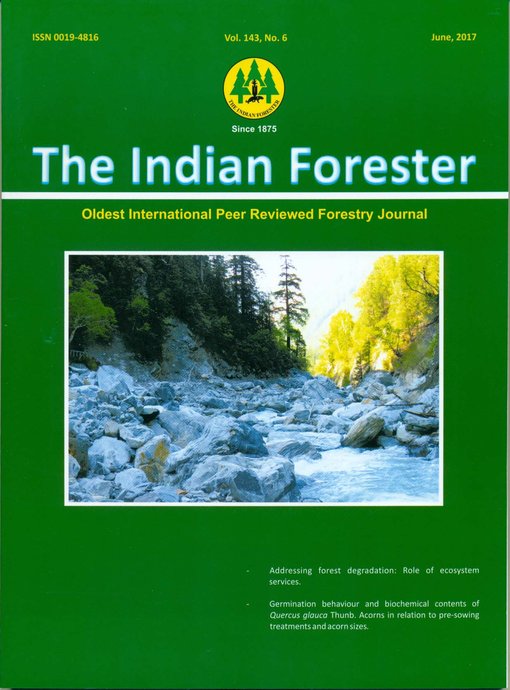Addressing forest Degradation: Role of Ecosystem Services
DOI:
https://doi.org/10.36808/if/2017/v143i6/115825Keywords:
Forest Ecosystem Services, Forest Degradation, Beneficiary Pays Principle, Payment For Ecosystem Services.Abstract
Forest ecosystem services are the consumptive benefits from forests like timber, non-timber forest products, genetic resources and fresh water along with non-consumptive benefits such as ecotourism. They also include functional benefits like carbon sequestration and storage, hydrological services, watershed protection, biological control and pollination. Despite high importance attached to forest ecosystems for providing goods and services, the communities and private individuals often lack incentives to protect and conserve forests resulting in their degradation. Ironically, India's forests also face a similar situation wherein despite gradually increasing forest and tree cover, the quality of forests is not of the desired level as evident from poor natural regeneration, unregulated grazing, and high incidences of fire, illicit felling, girdling and lopping. Recognition to the forest ecosystem services and their mainstreaming in policy and action for incentivizing the providers of these services, viz., communities, individuals and departments is seen world over as a solution to tackle the problem of forest degradation. The paper taking clues from other countries articulate the need for a policy in line of 'Beneficiary Pays' principle wherein the providers of forest ecosystem services are duly rewarded so as to ensure that forests are not only saved from further degradation but also improved and conserved for posterity.References
Anon. (2006). Report of the Expert Committee on Net Present Value (Professor Kanchan Chopra Committee) Submitted to Hon'ble Supreme Court of India, 2006, MoEF, GoI, New Delhi.
Anon. (2013). State Policy on Payment for Ecosystem Services in Himachal Pradesh. Department of Forests, Govt. of Himachal Pradesh, Shimla.
Anon. (2014). The Economics of Ecosystems and Biodiversity. India Initiative, Interim Report, Working Document, MoEF&CC, GIZ, p 92.
Anon. (2015). Report on Fourteenth Finance Commission, Chatrapati Shivaji Bhawan, New Delhi – 110016.
Bahuguna V.K. and Bisht N.S. (2013). Valuation of ecosystem goods and services from forests in India. Indian Forester, 139(1):1-13
Bisht N.S. (2016) Valuation of goods and services from forest of Mizoram. Env. And Forest Deptt. Mizoram.164p.
Brockett C.D. and Gottfried R.R. (2002). State Policies and the Preservation of Forest Cover: Lessons from contrasting public-policy regimes in Costa Rica, 37 Latin American Research Review, 10.
CESM (2013). Revision of rates of NPV applicable for different class/category of forests. Centre for Ecological Services Management (CESM), Indian Institute of Forests Management (IIFM), Bhopal in collaboration with Forest Survey of India, June 2013.
CESM (2015). Economic Valuation of Tiger Reserves in India: A Value+ Approach. CESM, Indian Institute of Forests Management, Bhopal, January 2015.
Costanza R., d Arge R., de Groot R., Farber S., Grasso M., Hannon B., Limburg K., Naeem S., OneillR.V., Paruelo J.,Raskin R.G., SuttonP., Vanden Belt M. (1997). The Value of the World's Ecosystem Services and Natural Capital. Nature, 387:253-260.
FONAFIFO (2006). Distribución de las hectáreas y árboles contratadas en Pago de Servicios Ambiéntales, por año y por modalidad, 2006; http://www.fonafifo.com/ text_files/servicios _ambientales/distrib_ ha_Contratadas.pdf.
Haripriya G.S. (1998). Forest resource accounting: Preliminary estimates for the State of Maharashtra. Development policy review, 16(2): 131151.
ISFR (2013). Indian State of Forest Report – 2013, Forest Survey of India, MoEF& CC, GoI, Dehradun.
ISFR (2015). Indian State of Forest Report – 2015, Forest Survey of India, MoEF& CC, GoI, Dehradun.
Lal J.B. (1992). Economic value of India's forest stock. In: The Price of Forests (Agarwal, A. ed.). Proceedings of a seminar on the economics of the sustainable use of forest resources, New Delhi, 2-4 April 1990. New Delhi: Centre for Science and Environment. pp. 43-48.
MEA (2005). Ecosystems and Human Well-being: Wetland and water. Synthesis. Millennium Ecosystem Assessment. Island Press, Washington, DC:
Singh S. (2008). PES in India from the Bottom-Up. Down to Earth, 15 Nov 2008. Centre for Science and Environment, Delhi.
Steed C.B. (2007). Government Payments for Ecosystem Services-Lessons from Costa Rica. Journal of Land Use & Environmental Law, 23 (1): 177-202.
USDA (2007). Valuing Ecosystem Services: Capturing the true value of nature's capital.USDA, Washignton, D.C., USA.
Verma M. (2000). Economic valuation of forests of Himachal Pradesh. Report on economic component of Himachal Pradesh forestry sector review: 7 submitted to the International Institute of Environmental Development, London, UK.
Weimer David L. and Vining Aidan R. (2005). Policy Analysis: Concepts and Practice, 4th Edition. Upper Saddle River, New Jersey.
World Bank (2007). WB AAA Program China policy Note (42177). East Asia and Pacific Region, The World Bank, Washington, D.C.
World Bank (2016). http://www.worldbank.org/en/news/feature/2016/03/18/why-forests-are-key-to-climate-water-health-andlivelihoods.
www.pdx.edu/sustainability/ecosystem-services-valuation-workshop. Principles Guiding Assessments of Ecosystem Services. USDA, Washington D.C., USA.
Downloads
Downloads
Published
How to Cite
Issue
Section
License
Unless otherwise stated, copyright or similar rights in all materials presented on the site, including graphical images, are owned by Indian Forester.





